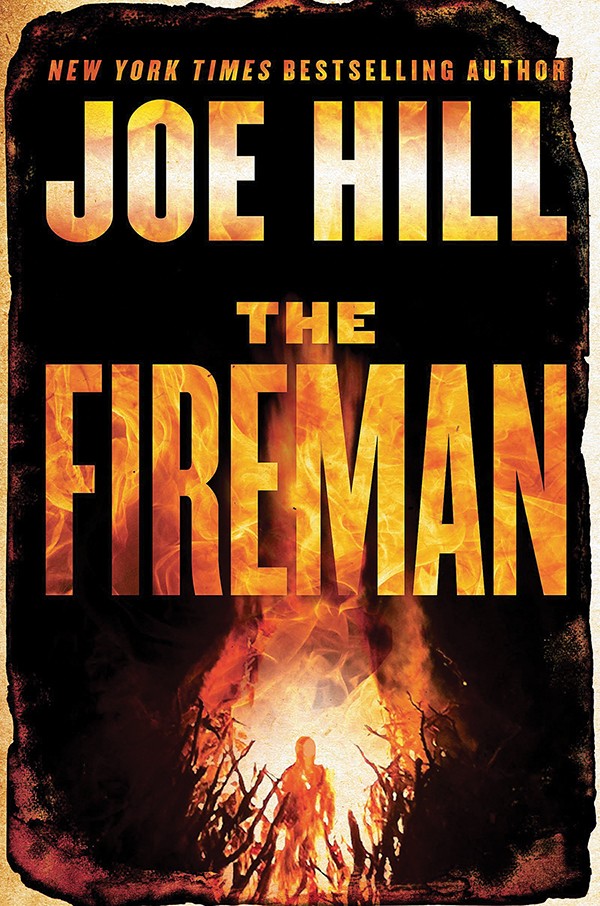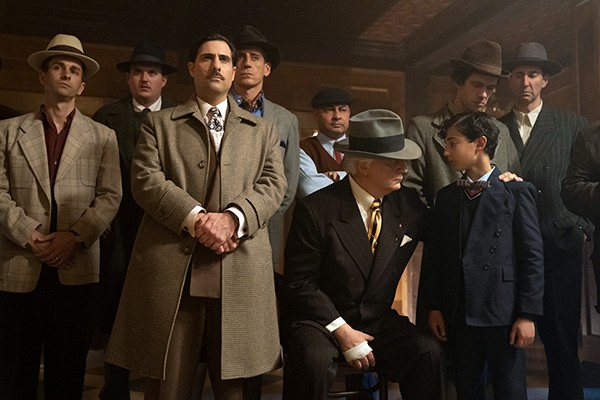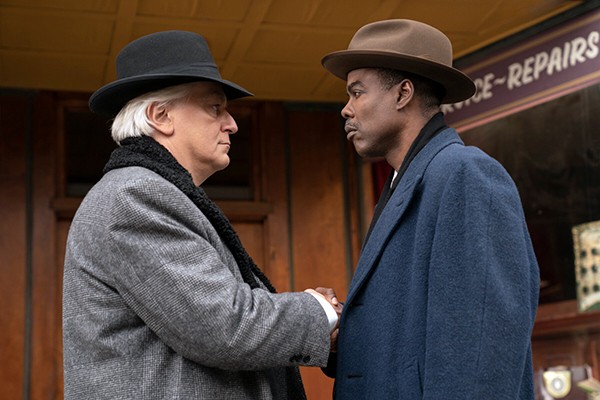The Fireman by Joe Hill
William Morrow, $28.99, 768 pp.
Stephen King is royalty in more than name — he is the bona fide king of horror novels, and his son, Joe Hill, is poised to inherit the throne. Hill has been steadily cranking out compelling fiction since he arrived on the scene with his chilling short story collection, 20th Century Ghosts (PS Publishing), in 2005, and his newest novel, The Fireman, may stand as his best yet.
The Fireman takes place in the weeks and months after a new pandemic begins to ravage the planet. The world, including the novel’s protagonist, Harper Grayson, watches in terror as a parasitic fungus spreads across the globe. Once a person is infected with the spore, they run the risk of spontaneous combustion. What’s worse, no one knows how the spore spreads or what triggers a person’s going up in flames once they have been infected.

The novel’s focus is on how we cope with fear, and, though Harper lives with constant awareness that her life can literally go up in smoke at any moment, her determination to appreciate each day remaining to her makes her an inspiring character and the perfect protagonist for Hill’s pandemic novel. She stands as one of the strong female protagonists who are becoming a (welcome) trend in science fiction and horror novels (See also Annihilation by Jeff VanderMeer and Station Eleven by Emily St. John Mandel).
The end result is a novel that will leave you wondering how you blazed (pun intended) through more than 700 pages in just a few sittings. In fact, the book’s weight may be the only real deterrent to reading it, but look at the bright side — you won’t want to part with Harper, Allie, or the Fireman once you’ve met them, and for 768 pages you won’t have to. — Jesse Davis
You Will Know Me by Megan Abbott
Little, Brown and Company, $26, 342 pp.
I read several of Megan Abbott’s novels before I realized that they are YA. It’s Abbott’s preferred subject matter that makes them so: teen girls. In books such as The Fever and Dare Me, Abbott has created a virtual Bad Girls Club — cheerleaders driven psycho by competition, sisters who put themselves in harm’s way for some control, schoolmates taken by hysteria in a bid to belong, and so on. Abbott seems to tap into that thing that makes ordinary teen girls so dangerous in that toxic mix of hormones and lack of sense of self, and then she dials it up a tick or two to homicidal.
Her latest Little Miss Danger in You Will Know Me is Devon Knox, an elite gymnast. The lives of Mom, Dad, and little brother all revolve around her schedule. Spare funds are sucked into leotards and treadmills. It’s as if the four of them make up a machine that has the sole purpose of getting to the Olympics. Then someone dies.
What follows is not so much a whodunnit because the “aha” moment can be intuited all along. Instead, it’s a slow peeling away of lies and stubborn beliefs — all that stuff that tends to bury the truth.
Perhaps the dominant strand through the story, beyond the teen drama, is the complicity of grown folks. Devon’s mother recognizes something in her daughter that the parent in her can’t express; Devon’s father, the girl’s biggest cheerleader, may be the most harmful influence of all. — Susan Ellis
The Sun & the Moon & the Rolling Stones by Rich Cohen
Spiegel & Grau, $30, 400 pp.
When I first received a copy of The Sun & the Moon & the Rolling Stones, I put it to the side, where I was prepared to let it sit unread. Cohen is a fine writer and reporter for Rolling Stone and traveled with the Stones beginning in the 1990s with the band’s Voodoo Lounge tour. I saw them at the Liberty Bowl on that tour. They were good, but who the hell wants to read an entire book on ’90s-era Stones?
I browsed through the book, though, to find it’s actually a history of the band, so I was a bit more intrigued. But still, come on, it’s been told before. And it’s all here — Mick and Keith’s meeting on the train platform after all those years, the blues, Stones vs. Beatles, the slumbering first hint of “(I Can’t Get No) Satisfaction,” and the drugs, drugs, drugs. It seems that every new generation of writers has to discover the group, and, since Cohen and I are roughly the same age, this is mine.
And therein lies the magic — seeing that long and rich history through a new set of eyes, a new set of interviews that, albeit coming from the usual cast of characters, are now tinged with age and perspective and (dare I say?) wisdom. And there are some nuggets in here, even for someone who’s read the articles and biographies and memoirs. For instance, I’d never heard that the Hells Angels attempted to assassinate Mick Jagger in retaliation for the botched Altamont concert. The 1979 plan to come ashore as the singer vacationed at Andy Warhol’s estate in Montauk was aborted only after their boat overturned in “a freakish swell,” leaving the Angels to swim for their lives.
Cohen’s prose is good, if not a bit over the top at times, just as rock-and-roll should be (he was an initial collaborator with Jagger and Martin Scorsese on the recently canceled HBO series Vinyl). “The Stones are a story that I’ve studied all my life,” he writes. “I’ve studied it as the ancients studied war. It’s my Hemingway, Dickens, Homer. I’ve studied it in books, on vinyl, and up close. Yet it keeps surprising me.” — Richard J. Alley
Before the Fall
By Noah Hawley
Grand Central Publishing, $26, 400 pp.
A private jet takes off from Martha’s Vineyard heading to New York’s Teterboro Airport with 11 souls aboard. Eighteen minutes later it ditches into the ocean and only two survive — a down-on-his-luck artist and the 4-year-old son of media mogul David Bateman. This scenario sets up Noah Hawley’s novel Before the Fall, a smooth flight of fiction, from takeoff to its satisfying conclusion.
The book is broken into chapters delving into each character’s backstory — characters that are no longer players within the present-day story. But it’s these backstories that help to unfurl the mystery of why the plane went down. The passengers include a hedge-fund manager who has been laundering money for enemy nations such as North Korea and Iran, and is due for indictment; Bateman’s 10-year-old daughter, a victim of kidnapping earlier in her life; the security man hired to guard the family around the clock; the captain and co-pilot; and a flight attendant.
As the painter, Scott Burroughs, struggles to right his life and make sense of his place as a crash survivor and hero, he encounters the difficulty of staying out of the public eye. A blowhard television pundit the likes of Rush Limbaugh or Glenn Beck, who works for Bateman’s ALC Network (think: FOX), works to turn the tragedy and the improbability of a poor painter being only one of two survivors into a Kardashian-like “news item.”
In addition to novels, Hawley has penned scripts for television and film, and is currently executive producer, writer, and showrunner on FX’s series Fargo. His experience and skill shows here as the back-and-forth storytelling is quick-paced and compelling, yet its whodunit component is just beneath the surface as it is the characters themselves who move the story along. I would put this book at the top of any summer reading list, as long as your travel plans involve a long drive and not a short flight. — Richard J. Alley
Everyone Brave is Forgiven
By Chris Cleave
Simon & Schuster, $26.99, 432 pp.
I read two books while on vacation that I will give my stamp as proven beach reads. One is the biography of a rock-and-roll band and the other is a novel enmeshed in the bombing of London during Germany’s blitzkrieg of World War II. This passage from The Sun & the Moon & the Rolling Stones bridges the two books with my hometown sensibilities: “Being fifteen when Hitler becomes a Nazi makes you [Chicago bluesman] Lewis Jones. Being the same age when Elvis releases “Heartbreak Hotel” makes you [Rolling Stones founder] Brian Jones.”
Everyone Brave is Forgiven joins 2014’s All the Light We Cannot See by Anthony Doerr and The Invisible Bridge by Julie Orringer four years before as three astounding novels set in the early years of WWII. These books are not stories seen through the lens of American field glasses, there is no Roosevelt stepping in to make speeches and save the day here. These are tales of heartbreak and physical pain and a sensation that the world was truly ending.
So it’s perfect for the beach!
Everyone Brave is Forgiven opens as the Germans are pushing into Paris. London is preparing, but the main characters — Mary, a young socialite; and Tom, an education administrator — are untouched by what looms ahead. This is a touching point of view for a book about war: that moment just before all hell breaks loose. That moment when there is still love in the air and humor in conversation, and when possibility is everything.
Needless to say, things don’t stay rosy for long. Mary sheds her station to, first, teach school, and then work more directly in the war effort. Tom clings to his love for Mary even as guilt pervades his heart when his best friend, Alastair, writes home about life on the front lines. Mary’s concern for a student of hers, an African-American boy who is the son of an American entertainer, shows the power of the protectors during times of crisis particularly well. Through the death and destruction — and the eradication of any possibility — Cleave finds a light that shines through. — Richard J. Alley
The Innocents (A Quinn Colson Novel)
By Ace Atkins
G.P. Putnam’s Sons, $27, 384 pp.
Perhaps the scariest aspect of the gruesome murder in Jericho, Mississippi, is the closeness of it all. New York Times bestselling author Ace Atkins’ fictional Tibbehah County lies only 100 miles away from Memphis, and creates an uneasy proximity to the well-crafted crime and corruption that lurks so near.
The latest in Atkins’ “Quinn Colson” series finds the titular protagonist, fresh from another tour of duty in Afghanistan, investigating the murder of a girl who has been set on fire walking down an empty highway. Before delving into the intrigues of backwater murder, Atkins takes time to painstakingly construct the danger and desperation of those who choose to live their lives in Jericho. Crime is heavy, while rape, murder, and racism are everyone’s closest neighbors. By the time we see the burning body of 17-year-old Milly Jones walking down the deserted highway, we know exactly what to expect from Jericho and why the city can’t handle the attention of an impending media circus.
While Atkins nails the application of a dreary and depressing setting, the buildup and wide range of character perspectives sets the ball rolling a little too late. The murder doesn’t take place until about page 130, which asks for a bit of commitment from the undecided reader. Plus, with so many scattered contributors to the narrative, it’s hard to really feel connected to many of the characters, save for the recurring Quinn Colson and current Sheriff Lillie Vergil.
The Innocents is still a good read. I’d recommend starting with the first Quinn Colson novel in order to be familiar with the recurring cast of characters and the Colson family dynamic. Several figures from his past are frequently referenced, and while they aren’t crucial to the storyline, they do add to the ongoing Colson narrative. Overall, The Innocents is a decent read. Pacing issues affect the plotline, but Atkins pulls in his readers with another dark look at some of the buried darkness in the Deep South. — Sam Cicci


